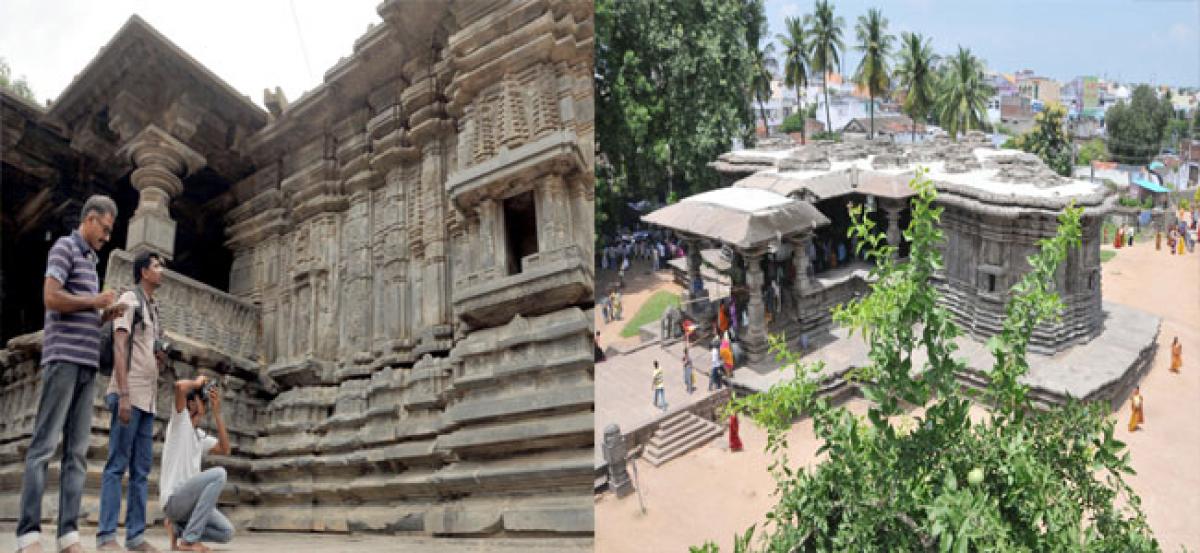Live
- TRSMA appeals to retain CGPA system for student well-being
- Their ‘passion’ for vines, flowers reaps benefits!
- Happy Tidings...Interim relief balm for state public sector employees
- All set to obtain GI tag for Balanagar Custard Apple
- Centre announces Rs 142 crore for Ramappa, Somashila tourist circuits
- Poorest of the poor will get roof over head under Indiramma: CM Revanth
- Govt keen on providing pothole-free roads: HM
- CM to disburse pension in Nemakallu today
- Jagan’s mindless decisions caused huge loss to RTC: Zonal chief Sannapureddy
- MLA Nani slams former MLA Chevireddy for false allegations
Just In

In what is termed as a monumental project, the Archaeological Survey of India (ASI) took up a study of the structural temples of the Kakatiya reign that have survived the tide of time, intending to gain more insight, document and immortalise the art, architectural and engineering excellence digitally.
Warangal: In what is termed as a monumental project, the Archaeological Survey of India (ASI) took up a study of the structural temples of the Kakatiya reign that have survived the tide of time, intending to gain more insight, document and immortalise the art, architectural and engineering excellence digitally.
Kakatiya dynasty, evolved and flourished between AD 1083 and 1323, left its imprint in the form of temples and structures that even today give us a glimpse of glorious past.
Albeit much was talked about Kakatiyas through the centuries, there was never a comprehensive study conducted on structures and temples of the dynasty spread across as far as Kanchipuram in the south.
The ASI, which proposed to document the magnificence of a cluster of temples constructed during the period of Kakatiyas, last year, has finally got down to collect the measurements and photographs of structures in 1,000 Pillars temple in Hanamkonda and Ramappa temple in Palampet, 70km from Warangal, to start with.
ASI Superintending Archaeologist (southern India) D Kanna Babu told The Hans India: “This is a first-of-its-kind study initiated under the Temple Survey Project in southern region. However, the ASI had conducted a study of temples structures of Cholas and Vaisalas in the past, the latest project will document the Kakatiyas architecture in an exhaustive manner using photogrammetry, satellite imagery and other advanced tools.”
The study will be useful in many ways, he asserted, elaborating that the study which includes minute details such as measurements of Adhishtana (base of temple wall), vimana (temple tower), garbhagriha (sanctum) etc, is of immense help in the evolution and comparative studies.
As the derivation of study is available in digitised formats, it can be thoroughly useful to fine arts and architect students. Moreover, the study also provides inputs for the conservation of several temples, besides heralding marvel of architectural engineering of the Kakatiyas, he said.
So far, the authorities have identified around 100 temples, a few also in Guntur, Prakasam and Kurnool districts of Andhra Pradesh, belonging to the Kakatiya dynasty and the number is likely to go up, it’s learnt. Intermittently, the teams will go back to their Chennai headquarters where they computerise the collected data and come back to resume the work. This multi-purpose survey is expected to be completed in one year.
By Adepu Mahender

© 2024 Hyderabad Media House Limited/The Hans India. All rights reserved. Powered by hocalwire.com







